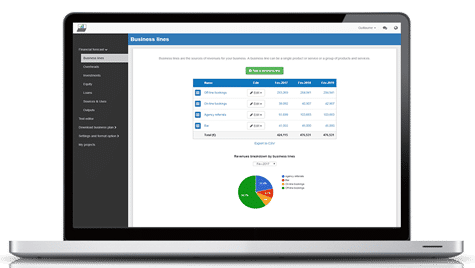How to create a financial forecast for a flower shop?
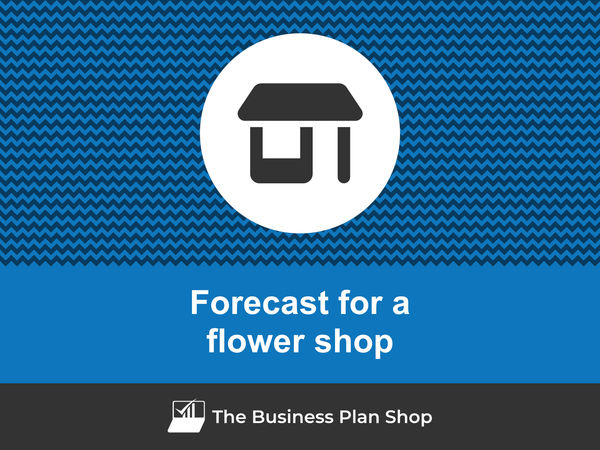
If you are serious about keeping visibility on your future cash flows, then you need to build and maintain a financial forecast for your flower shop.
Putting together a flower shop financial forecast may sound complex, but don’t worry, with the right tool, it’s easier than it looks, and The Business Plan Shop is here to guide you.
In this practical guide, we'll cover everything you need to know about building financial projections for your flower shop.
We will start by looking at why they are key, what information is needed, what a forecast looks like once completed, and what solutions you can use to create yours.
Let's dive in!
Why create and maintain a financial forecast for a flower shop?
In order to prosper, your business needs to have visibility on what lies ahead and the right financial resources to grow. This is where having a financial forecast for your flower shop becomes handy.
Creating a flower shop financial forecast forces you to take stock of where your business stands and where you want it to go.
Once you have clarity on the destination, you will need to draw up a plan to get there and assess what it means in terms of future profitability and cash flows for your flower shop.
Having this clear plan in place will give you the confidence needed to move forward with your business’s development.
Having an up-to-date financial forecast for a flower shop is also useful if your trading environment worsens, as the forecast enables you to adjust to your new market conditions and anticipate any potential cash shortfall.
Finally, your flower shop's financial projections will also help you secure financing, as banks and investors alike will want to see accurate projections before agreeing to finance your business.
Need a solid financial forecast?
The Business Plan Shop does the maths for you. Simply enter your revenues, costs and investments. Click save and our online tool builds a three-way forecast for you instantly.
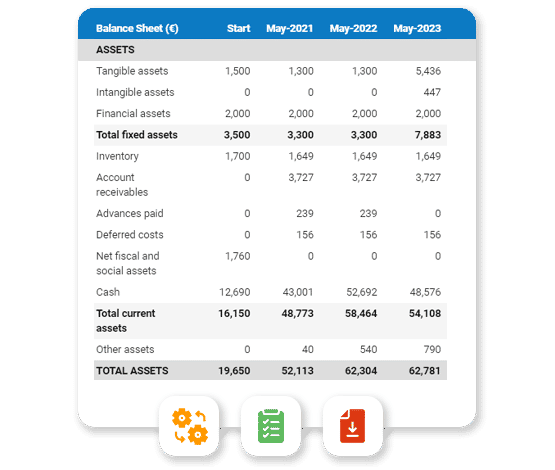
What information is used as input to build a flower shop financial forecast?
A flower shop's financial forecast is only as good as the inputs used to build it.
If you are creating (or updating) the forecast of an existing flower shop, then you mostly need your accounting information, key historical operating non-financial data, and your team’s input on what to expect for the coming years.
If you are building financial projections for a flower shop startup, you will need to have done your research and have a clear picture of your competitive environment and go-to-market strategy so that you can forecast sales accurately.
For a new venture, you will also need a precise list of the resources needed to keep the flower shop running on a day-to-day basis and a list of the equipment and expenditures required to start the business (more on that later).
Let's now take a closer look at the elements that make up your flower shop's financial forecast.
The sales forecast for a flower shop
The sales forecast, also called topline projection, is normally where you will start when building your flower shop financial forecast.
Creating a coherent sales projection boils down to estimating two key drivers:
- The average price
- The number of monthly transactions
To do this, you will need to rely on historical data (for an existing business), market research data (for both new and existing flower shops), and consider the elements below:
- Weather Conditions: Weather can greatly impact the average price and number of transactions for a flower shop. In the spring and summer months, when the weather is warmer and more pleasant, customers may be more likely to purchase flowers for special events such as weddings and graduations. On the other hand, harsh weather conditions such as heavy rain or snow may lead to a decrease in foot traffic and therefore fewer sales.
- Holiday Seasons: The holiday season is a crucial time for a flower shop, as many people purchase flowers as gifts for their loved ones. However, the demand for flowers and the average price may vary depending on the holiday. For example, during Valentine's Day, the demand for roses may increase, leading to a higher average price, while during Mother's Day, there may be a higher demand for mixed bouquets and therefore a lower average price.
- Availability of Seasonal Flowers: The availability of seasonal flowers can also affect the average price and number of transactions for a flower shop. When certain flowers are in season, they may be more readily available and therefore lower in price, leading to a decrease in the average price. On the other hand, when a particular flower is out of season, it may be more difficult to source, leading to a higher average price.
- Competition: The level of competition in the area can also impact a flower shop's sales forecast. If there are many other flower shops in the vicinity, it may be more challenging to attract customers and maintain a steady flow of transactions. This may lead to lower average prices as flower shops compete with each other for customers.
- Changes in Consumer Preferences: Consumer preferences for different types of flowers and arrangements can also affect a flower shop's sales forecast. For example, if there is a sudden trend towards more exotic or unique types of flowers, the shop may need to adjust its inventory and pricing accordingly to meet the demand.
After the sales forecast comes the operating expenses budget, which we will now look into in more detail.
Need inspiration for your business plan?
The Business Plan Shop has dozens of business plan templates that you can use to get a clear idea of what a complete business plan looks like.

The operating expenses for a flower shop
The next step is to estimate the costs you’ll have to incur to operate your flower shop.
These will vary based on where your business is located, and its overall size (level of sales, personnel, etc.).
But your flower shop's operating expenses should normally include the following items:
- Staff Costs: This includes salaries, wages, and benefits for all employees, including florists, sales staff, and administrative staff.
- Rent: You will need to pay rent for your storefront and any additional storage or work space.
- Utilities: This includes electricity, water, and gas for your shop.
- Inventory: This includes the cost of purchasing flowers, plants, and other supplies for your shop.
- Marketing and Advertising: You will need to budget for advertising your shop, whether it's through print, online, or other means.
- Equipment and Supplies: This includes the cost of purchasing and maintaining equipment such as refrigerators, vases, and tools for arranging flowers.
- Accountancy Fees: You may need to hire an accountant to help you with bookkeeping, taxes, and other financial tasks.
- Insurance Costs: You will need to insure your shop and its contents, as well as have liability insurance for any accidents or injuries that may occur on your premises.
- Software Licenses: You may need to purchase software for tasks such as managing inventory, scheduling appointments, and processing payments.
- Banking Fees: You will need to budget for fees associated with maintaining a business bank account, such as transaction fees and monthly account fees.
- Taxes: You will need to pay income taxes on your profits and sales taxes on any items sold.
- Repairs and Maintenance: You may need to budget for repairs and maintenance of your shop, equipment, and vehicles used for deliveries.
- Training and Education: You may want to invest in training and education for yourself and your employees to improve your skills and knowledge in the floral industry.
- Packaging and Shipping: If you offer delivery services, you will need to budget for packaging materials and shipping fees.
- Professional Memberships and Subscriptions: You may want to join professional floral associations or subscribe to industry publications to stay updated on industry trends and best practices.
This list is not exhaustive by any means, and will need to be tailored to your flower shop's specific circumstances.
What investments are needed to start or grow a flower shop?
Creating and expanding a flower shop also requires investments which you need to factor into your financial forecast.
Capital expenditures and initial working capital items for a flower shop could include elements such as:
- Flower inventory: This includes all the flowers and plants that you will purchase to be sold in your shop. This can also include any necessary storage equipment, such as refrigerators or shelving units, to keep the flowers fresh.
- Decor and displays: As a flower shop, creating an inviting and aesthetically pleasing atmosphere is important for attracting customers. This can include expenses for purchasing vases, containers, and other decorative items to showcase your flowers.
- Equipment and tools: In order to create beautiful arrangements and bouquets, you will need certain tools and equipment, such as scissors, floral tape, and wire cutters. These are essential for the day-to-day operations of your flower shop.
- Delivery vehicles: If you offer delivery services, you may need to purchase a vehicle specifically for this purpose. This can include expenses for a van or truck, as well as any necessary maintenance and insurance costs.
- Point-of-sale system: A modern flower shop will likely use a computerized point-of-sale system to track sales and inventory. This can include expenses for purchasing the software, hardware, and any necessary training for your staff.
Again, this list is not exhaustive and will need to be adjusted according to the circumstances of your flower shop.
Need a convincing business plan?
The Business Plan Shop makes it easy to create a financial forecast to assess the potential profitability of your projects, and write a business plan that’ll wow investors.
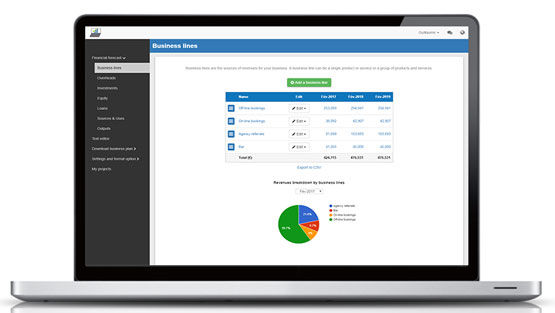
The financing plan of your flower shop
The next step in the creation of your financial forecast for your flower shop is to think about how you might finance your business.
You will have to assess how much capital will come from shareholders (equity) and how much can be secured through banks.
Bank loans will have to be modelled so that you can separate the interest expenses from the repayments of principal, and include all this data in your forecast.
Issuing share capital and obtaining a bank loan are two of the most common ways that entrepreneurs finance their businesses.
What tables compose the financial plan for a flower shop?
Now let's have a look at the main output tables of your flower shop's financial forecast.
The profit & loss forecast
The forecasted profit & loss statement will enable you to visualise your flower shop's expected growth and profitability over the next three to five years.
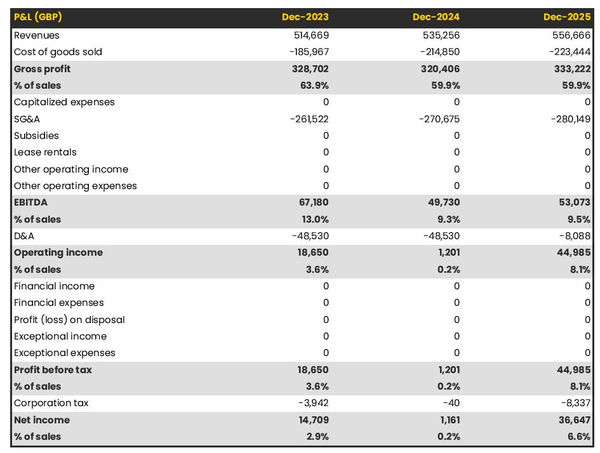
A financially viable P&L statement for a flower shop should normally show:
- Sales growing above inflation
- Stable or expanding (ideally) profit margins
- A net profit
This will of course depend on the stage of your business: a new venture might be loss-making until it reaches its breakeven point in year 2 or 3, for example.
The projected balance sheet
The projected balance sheet gives an overview of your flower shop's financial structure at the end of the financial year.
It is composed of three categories of items: assets, liabilities and equity:
- Assets: are what the business possesses and uses to produce cash flows. It includes resources such as cash, buildings, equipment, and accounts receivable (money owed by clients).
- Liabilities: are the debts of your flower shop. They include accounts payable (money owed to suppliers), taxes due and bank loans.
- Equity: is the combination of what has been invested by the business owners and the cumulative profits to date (which are called retained earnings). Equity is a proxy for the value of the owner's stake in the business.
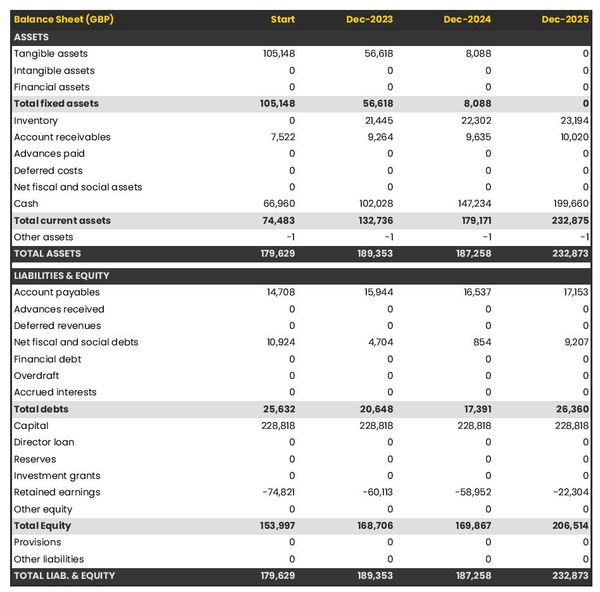
The projected cash flow statement
A projected cash flow statement for a flower shop is used to show how much cash the business is generating or consuming.
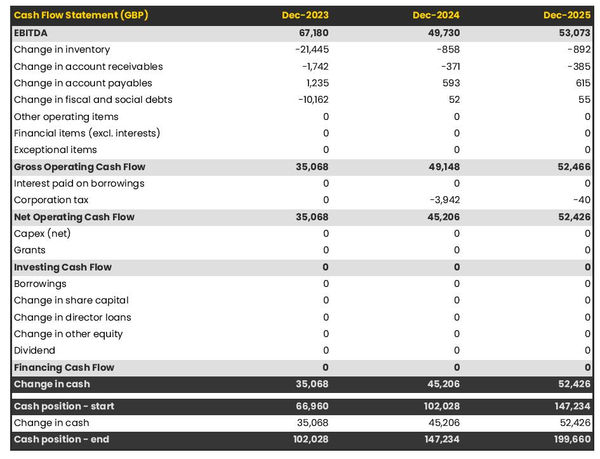
The cash flow forecast is usually organised by nature to show three key metrics:
- The operating cash flow: do the core business activities generate or consume cash?
- The investing cash flow: how much is the business investing in long-term assets (this is usually compared to the level of fixed assets on the balance sheet to assess whether the business is regularly maintaining and renewing its equipment)?
- The financing cash flow: is the business raising new financing or repaying financiers (debt repayment, dividends)?
Cash is king and keeping an eye on future cash flows is imperative for running a successful business. Therefore, you should pay close attention to your flower shop's cash flow forecast.
If you are trying to secure financing, note that it is customary to provide both yearly and monthly cash flow forecasts in a financial plan - so that the reader can analyze seasonal variation and ensure the flower shop is appropriately capitalised.
Need a solid financial forecast?
The Business Plan Shop does the maths for you. Simply enter your revenues, costs and investments. Click save and our online tool builds a three-way forecast for you instantly.

Which tool should you use to create your flower shop's financial forecast?
Creating your flower shop's financial forecast may sound fairly daunting, but the good news is that there are several ways to go about it.
Using online financial projection software to build your flower shop's forecast
The modern and easiest way to build a forecast is to use professional financial projection software such as the one we offer at The Business Plan Shop.
There are several advantages to using specialised software:
- You can easily create your financial forecast by letting the software take care of the financial calculations for you without errors
- You have access to complete financial forecast templates
- You get a complete financial forecast ready to be sent to your bank or investors
- You can easily track your actual financial performance against your financial forecast, and recalibrate your forecast as the year goes by
- You can create scenarios to stress test your forecast's main assumptions
- You can easily update your forecast as time goes by to maintain visibility on future cash flows
- You have a friendly support team on standby to assist you when you are stuck
- It’s cost-efficient and much cheaper than using an accountant or consultant (see below)
If you are interested in this type of solution, you can try our forecasting software for free by signing up here.
Calling in a financial consultant or chartered accountant
Enlisting the help of a consultant or accountant is also a good way to obtain a professional flower shop financial forecast.
The downside of this solution is its cost. From experience, obtaining a simple financial forecast over three years (including a balance sheet, income statement, and cash flow statement) is likely to cost a minimum of £700 or $1,000.
The indicative cost above, is for a small business, and a forecast is done as a one-shot exercise. Using a consultant or accountant to track your actuals vs. forecast and to keep your financial projections up to date on a monthly or quarterly basis will cost a lot more.
If you opt for this solution, make sure your accountant has in-depth knowledge of your industry, so that they may challenge your figures and offer insights (as opposed to just taking your assumptions at face value to create the forecast).
Why not use a spreadsheet such as Excel or Google Sheets to build your flower shop's financial forecast?
Creating an accurate and error-free flower shop financial forecast with a spreadsheet is very technical and requires a deep knowledge of accounting and an understanding of financial modelling.
Very few business owners are financially savvy enough to be able to build a forecast themselves on Excel without making mistakes.
Lenders and investors know this, which is why forecasts created on Excel by the business owner are often frowned upon.
Having numbers one can trust is key when it comes to financial forecasting and to that end using software is much safer.
Using financial forecasting software is also faster than using a spreadsheet, and, with the rise of artificial intelligence, software is also becoming smarter at helping us analyse the numbers to make smarter decisions.
Finally, like everything with spreadsheets, tracking actuals vs. forecasts and keeping your projections up to date as the year progresses is manual, tedious, and error-prone. Whereas financial projection software like The Business Plan Shop is built for this.
Need a convincing business plan?
The Business Plan Shop makes it easy to create a financial forecast to assess the potential profitability of your projects, and write a business plan that’ll wow investors.

Use our financial forecast templates for inspiration
The Business Plan Shop has dozens of financial forecast examples available.
Our templates contain both a financial forecast and a written business plan which presents, in detail, the company, the team, the strategy, and the medium-term objectives.
Our templates are a great source of inspiration, whether you just want to see what a complete business plan looks like, or are looking for concrete examples of how you should model financial elements in your own forecast.
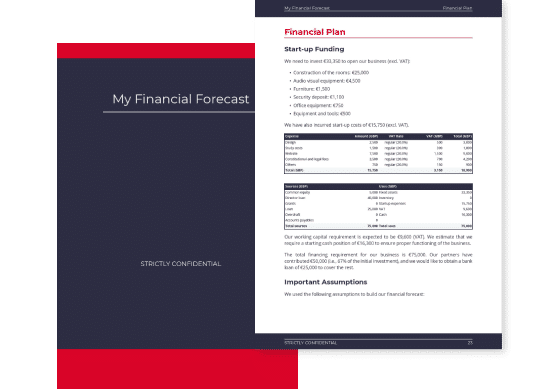
Takeaways
- Having a financial forecast enables you to visualise the expected growth, profitability, and cash generation for your business over the next three to five years.
- Tracking actuals vs. forecast and keeping your financial projections up-to-date is the only way to get a view on what your flower shop future cash flows may look like.
- Using financial forecasting software is the mordern and easy way to create and maintain your forecasts.
This is the end of our guide on how to build the financial forecast for a flower shop, we hope you found it useful. Don't hesitate to contact us if you want to share your feedback or have any questions.
Need inspiration for your business plan?
The Business Plan Shop has dozens of business plan templates that you can use to get a clear idea of what a complete business plan looks like.

Also on The Business Plan Shop
Know someone who owns or is thinking of starting a flower shop? Share our forecasting guide with them!

